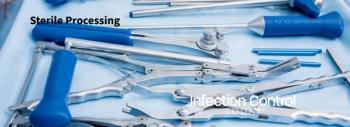
Identifying and Combatting Surgical Instrument Misuse and Abuse
Under perfect circumstances, surgical instruments are carefully handled, transported and cleaned-according to industry best practices and OEM instructions. But in a busy surgery department or facility, the rush of procedures and pressure to turn equipment around quickly can lead to shortcuts that ultimately damage surgical instruments.
By Karin Lillis
Under perfect circumstances, surgical instruments are carefully handled, transported and cleaned-according to industry best practices and OEM instructions. But in a busy surgery department or facility, the rush of procedures and pressure to turn equipment around quickly can lead to shortcuts that ultimately damage surgical instruments.
“Instruments wear and break down at different rates,” says Alisandra Rizzolo, vice president and general manager of customer care at Stryker. “The most common variables that affect equipment performance are improper cleaning or storage, dropping instruments and not following the OEM’s equipment maintenance schedule.”
These common forms of misuse tend to have a greater impact on more complex and delicate instruments, adds Gary Stroud, chief clinical officer of Prezio Health. “Laparoscopic instruments for example, possess delicate components and microscopic cavities which pose unique challenges for repair technicians and sterile processing professionals alike. The delicate construct and protective coatings of these instruments are often compromised in the absence of sound care and handling procedures.”
Additionally, failing to adequately inspect lumened instruments poses a “grave threat” to the integrity of the insulation-which can impact patient and clinician safety “with devastating consequences.” Along with increased risks for surgical incidence, “contaminated lumens that go undetected can continued damage to an instrument’s integrity-leading to costly and preventable repair charges,” Stroud says. “The root cause of these problems typically stems from a combination of inadequate training and the absence of a succinct preventative maintenance schedule.”
Where Breakdowns Occur
Consultant Paul Wafer, MBA, BS, RN, says instrument misuse falls into three categories:
- Surgeons and physicians. A surgeon, for example, may take a fine set of scissors and use it to cut bandages or Sutures-when the instrument is meant for fine tissue, notes Wafer, a principal at Alpha Consulting, Perioperative and Emergency Services Specialists, Manhattan Beach, Calif.
“Or a physician might be doing an endoscopic case and use the lens as a lever. That puts excess pressure on the lens and causes it to bend-ruining the alignment of the lenses inside the scope,” he says.
- Surgical technicians in the OR. “Look at the way the techs treat the instruments, both during and at the end of each case,” Wafer says. He cites a frequent error he sees during surgical procedures: The Association of Registered perioperative Nurses guidelines recommend keeping instruments clean by wiping them down with a sponge soaked in sterile water. “We frequently don’t see that being done. Blood dries and cakes on instruments, and they’re harder to clean,” he notes.
Improper point-of-use cleaning, says Stroud, ultimately, decreases the useful life of surgical instruments and put patients at risk for surgical site infections. Instruments should never be allowed to dry without removing biological materials. He notes that instruments need to be “tended to” immediately, consistent with manufacturers’ recommendations, to remove any obvious soil when instruments are prepared for transport to decontamination.
“Repeated failure to observe this practice can lead to residual bioburden and the development of difficult-to-remove biofilms,” Stroud explains. “Biofilm will compromise the passivation layer of stainless steel instruments, increase the frequency of costly repairs, and potentially render decontamination and sterilization processes less effective.”
Additional issues can arise if the instruments are soaked in saline or bleach-which are corrosive-rather than enzymatic cleaner and sterile water. “Depending on how long the sterile processing department (SPD) takes to get them cleaned, those instruments can be left in the saline for a while,” Wafer says. “You end up creating more damage.” Bleach is also corrosive, he notes.
Once the procedure is finished, OR staff can mishandle instruments when they prepare them for transport to sterile processing. “At the end of the case-rather than putting the instrumentation back into the appropriate trays-staff will throw all the instruments into a basin. Sometimes delicate instruments are on the bottom, with the heavier ones placed on top,” Wafer says. “The correct way? Put the clean instruments on the bottom, cover them with a towel and place the dirty instruments on top.” To break down any bioburden, the surgical techs should spray enzymatic foam or gel on the dirty instruments.
- SPD. Stroud says improper transport is a “common offender” against proper instrument handling. “How many times do we see a delicate rigid scope being transported for reprocessing from surgery, tossed among of a pile of used stainless steel instrumentation?” Stroud notes. Fragile equipment needs to be transported in approved containers that maintain a protective barrier and “prevent undue trauma to its components.”
OR and central supply staff should be periodically educated about handling all types of instruments-and proper handling techniques should be reinforced, Stroud explains.
“You have to pay attention to how instruments are transported to sterile processing and make sure they’re getting cleaned properly,” Wafer adds. “For example, are sterile processing staff maximizing the cleaning ability of the washer decontaminator? Are they restringing surgical instruments with the tips pointing up, so water can penetrate the container? You also want to make sure that the decontaminator properly lubricates instruments-otherwise you end up with sticky instruments that are hard to open and close.”
Consistency in Practice
“There needs to be consistency in practice-that’s where a lot of hospitals fall down,” Wafer says. He notes that both OR and sterile processing staff need to understand the entire process from preparing instruments at the end of a case through transport to the SPD.
“There has to be communication sterile processing and the OR,” Wafer notes. He suggests joint staff meetings that include both departments. “Often, there is a lot of finger pointing between the OR and SPD-they blame each other for problems that occur. That’s because they don’t know each other well. Communication is so important, and including both departments has a positive impact. I’ve seen it happen.
“A feedback mechanism could be used to track instruments that were not saturated with enzymatic foam or gel, improperly discarded sharps or delicate instruments at the bottom of a basin,” Wafer says. “You could start tracking and reporting at staff meetings. Don’t point the finger at an individual. You could track the numbers that are occurring so you can keep it objective.”
Preventive Maintenance is Key
A robust preventive maintenance program is key to ensuring surgical instruments are in proper working order. “From activity-based preventive maintenance on instrumentation to electric testing of power equipment, routine maintenance must be scheduled, communicated and documented on a consistent basis,” says Greg Bight, vice president of operations and business development, Prezio Health. “Resources to plan and track these schedules can be utilized from tracking systems and instrument repair vendors as available, however every facility should make these practices a daily priority in their SPD.”
“Some hospitals have really good programs, where preventive maintenance is programmed into the instrument management system. You have to have a good plan for preventive maintenance and a good process to ensure instrumentation, if it’s not functioning, gets pulled out of the tray and repaired,” Wafer says. “I’ve seen cases where someone has pointed out that an instrument was broken, but it still ended up on the procedure tray. You need a consistent way to tag damaged instruments so they are inspected by the repair company.”
Bight cautioned that all routine maintenance programs must always follow the manufacturer’s maintenance designations for use. “If properly implemented, routine maintenance will extend the life of instruments, reduce repair costs, increase customer satisfaction and improve patient safety,” he says.
Adds Rizzolo, “Routine maintenance programs should also include replacing parts, upgrading technology and calibrating equipment as needed, and testing equipment regularly.”
Selecting an Instrument Repair Company
“There are a lot of companies doing this kind of work, and many are very good. But a company is only as good as the individual performing the work,” Wafer says. “You need to know how well-trained the staff is. I’ve been in some hospitals where (scissors sharpened at the wrong angle and ruined.”
He also recommends examining the contract structure-is it by instrument, by tray or a monthly fee.
Bight recommends facilities ask the following questions:
-Is my service provider ISO certified for quality processes?
-Can my service provider recommend and support an effective preventative maintenance program?
-Do they possess a validation process for replacement parts?
-Will my service provider provide accredited education aimed at instructing my staff on proper care and handling techniques?
Adds Wafer, “You’ll want to know about the experience level of the person providing the service-how long have they been on the job, where did they learn their skills and what kind of equipment are they using to accomplish the task?” Wafer says. “Do they have the right engineering equipment in the mobile van or the facility where the repairs are performed?”
“To maximize instrument usability, consider partnering with an equipment service provider that can educate and support staff on best practices for handling, cleaning, maintaining and storing equipment,” Rizzolo says. “This includes performing maintenance on a regular schedule and using OEM tools and parts for repairs.”
She advises, “When selecting an equipment service provider, make sure you have a firm grasp on your facility’s needs because maintenance and repair companies can offer different levels of service. Once you have determined your needs, evaluate service providers based upon their availability and accessibility, knowing that equipment can break down at any time and quick response times will minimize downtime.
“It’s also important to note whether the service provider can offer on-site support or provide loaner equipment while yours is serviced to maximize your facility’s uptime. Lastly, inquire about the level of training and certifications held by their technicians and whether they have access to OEM parts and tools. Together, these elements are essential to ensure your instruments will function correctly during critical care moments.”
Karin Lillis is a freelance writer.
Newsletter
Stay prepared and protected with Infection Control Today's newsletter, delivering essential updates, best practices, and expert insights for infection preventionists.






